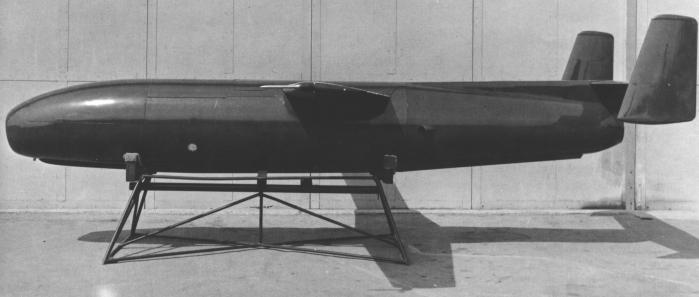Radioplane Q-1
In the late 1940s, the U.S. Air Force had a requirement for a jet-powered high-speed target drone. Radioplane submitted a design based on their earlier model RP-21 and RP-26 studies, and the first XQ-1 flew in 1950.
The XQ-1 was powered by a Giannini PJ39 11" pulsejet engine, and was launched from the ground using a rocket-propelled sled. In flight, the XQ-1 was radio controlled from the ground or another aircraft using an AN/APW-11 radar control set. The drone was recovered by a two-stage parachute system. The original XQ-1 had a single vertical tail, but this was soon changed to twin tails of reduced height to facilitate air launches from DB-26 Invader aircraft. A total of 28 XQ-1 vehicles were built.
The XQ-1's pulsejet was not very fuel efficient, limiting flight duration with wingtip tanks to only 60 minutes. Therefore at least one XQ-1 was modified to XQ-1A confuguration with a single Continental YJ69-T-3 turbojet. The XQ-1A also had a redesigned parachute deployment system.
 |
| Photo: Northrop |
| From left: XQ-1 (original), XQ-1 (modified), XQ-1A, YQ-1B |
The ultimate Q-1 model was the YQ-1B (Radioplane model RP-50), six of which were evaluated by the USAF in late 1953. It was powered by the same turbojet engine as the XQ-1A but was otherwise a significantly redesigned aircraft. Major difference was a new fuselage with a nose intake instead of the XQ-1A's side-mounted ones. The YQ-1B was usually air-launched by a DB-26, but the last two drones also had provisions for ground launching. Although there were apparently no basic flaws in the YQ-1B design, the program was terminated after the flight tests, because at that time the USAF had already selected the Ryan Q-2/BQM-34 Firebee as its standard jet-powered target drone. The YQ-1B formed the base for the Radioplane model RP-54D, which was ordered by the USAF as the GAM-67 Crossbow anti-radar missile.
 |
| Photo: Northrop |
| YQ-1B |
The designation XQ-3 was assigned to a Q-1 variant with plastic and fiberglass parts, but no further details are available. Most likely no XQ-3s were completed.
Specifications
Note: Data given by several sources show slight variations. Figures given below may therefore be inaccurate!
Data for XQ-1 (twin-tailed), YQ-1B:
| XQ-1 | YQ-1B | |
|---|---|---|
| Length | 6.10 m (20 ft) | 5.59 m (18 ft 4 in) |
| Wingspan | 4.38 m (14 ft 4.5 in) | |
| Diameter | 56 cm (22 in) | 76 cm (30 in) |
| Height | 1.21 m (3 ft 11.5 in) | 1.34 m (4 ft 5 in) |
| Weight | ? | 815 kg (1800 lb) |
| Speed | 530 km/h (330 mph) | 555 km/h (345 mph) |
| Ceiling | 4900 m (16000 ft) | ? |
| Endurance | 60 min | ? |
| Propulsion | Giannini XPJ39-GN-1 pulsejet | Continental YJ69-T-3 turbojet; 3.9 kN (880 lb) |
Main Sources
[1] Richard A. Botzum: "50 Years of Target Drone Aircraft", Northrop, 1985
[2] James C. Fahey: "United States Air Force and United States Army Aircraft 1947-1956", Ships and Aircraft, 1956
Back to Directory of U.S. Military Rockets and Missiles, Appendix 1
Last Updated: 20 March 2003